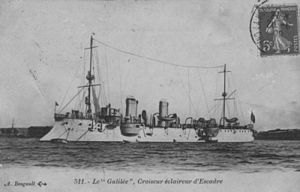
The Dévastation was an Dévastation-class ironclad battleship of the French Navy of central battery (casemate) design. She was used as a school ship for manoeuvres.

Courbet was an Dévastation-class ironclad central battery battleship of the French Navy.

Formidable was an ironclad barbette ship built for the French Navy between her keel laying in late 1879 and her completion in early 1889. She was the second and final member of the Amiral Baudin class. The ships of the class was designed in response to Italian naval expansion, and carried a main battery of three 370 mm (14.6 in) guns all mounted in open barbettes on the centerline. The armament was chosen after public pressure to compete with the very large guns mounted on the latest Italian ironclads.

Magenta was an ironclad barbette ship of the French Navy built in the 1880s and early 1890s. She was the third and final member of the Marceau class. The Marceau class was based on the earlier Amiral Baudin class of barbette ships, but with smaller guns: four 340 mm (13.4 in) weapons compared to the three 420 mm (16.5 in) guns of the earlier vessels. The ships introduced the lozenge arrangement for their main battery that became common for many French capital ships built in the 1890s. Magenta and her sister ships suffered from a number of problems, including poor stability, insufficient armor protection, and excessive displacement.

Marceau was an ironclad barbette ship built for the French Navy during the 1880s, the lead ship of her class. She served in the Mediterranean Squadron until 1900, when she was rebuilt and subsequently placed in reserve. She returned to service in 1906 as a torpedo training ship. During World War I, she served in Malta and Corfu as a submarine tender. The old ironclad was sold for scrapping in 1920, and while being towed to Toulon, she ran aground in a gale off Bizerte and became stranded. The wreck remained visible there until the 1930s.

Neptune was an ironclad barbette ship of the French Navy built in the 1880s and early 1890s. She was the second member of the Marceau class, which included two other vessels. The Marceau class was based on the earlier Amiral Baudin class of barbette ships, but with smaller guns: four 340 mm (13.4 in) weapons compared to the three 420 mm (16.5 in) guns of the earlier vessels. They introduced the lozenge arrangement for their main battery that became common for many French capital ships built in the 1890s. Neptune and her sister ships suffered from a number of problems, including poor stability, insufficient armor protection, and excessive displacement.
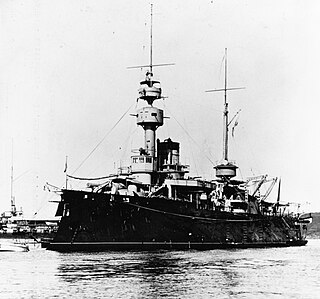
Amiral Baudin was an ironclad barbette ship of the French Navy built in the late 1870s and 1880s. She was the lead ship of the Amiral Baudin class, which included one other vessel, Formidable. The Amiral Baudin class was designed in response to Italian naval expansion, and carried a main battery of three 370 mm (14.6 in) guns all mounted in open barbettes on the centerline. The armament was chosen after public pressure to compete with the very large guns mounted on the latest Italian ironclads. Amiral Baudin was laid down in 1879 and was completed in 1888.

Hoche was an ironclad battleship built as a hybrid barbette–turret ship for the French Navy in the 1880s. Originally designed in response to very large Italian ironclads along the lines of the French Amiral Baudin class, by the time work on Hoche began, changes in French design philosophy led to a radical re-design that provided the basis for a generation of French capital ships. Her armament was reduced in size compared to the Amiral Baudins, and was placed in the lozenge arrangement that would be used for most French capital ships into the 1890s. Hoche suffered from serious stability problems that resulted from her large superstructure and low freeboard, which required extensive work later in her career to correct. The ship incorporated new technologies for the French Navy, including gun turrets for some of her main battery guns and compound armor plate.

Amiral Duperré was an ironclad barbette ship built for the French Navy in the 1870s and 1880s; she was the first vessel of that type built by France. She carried her main battery of four 34 cm (13.4 in) guns individually in open barbette mountings, which offered increased fields of fire compared to earlier central battery ships, though they were less well protected. Amiral Duperré was ordered as part of a French naval construction program aimed at countering the growth of the Italian fleet, which had begun work on the very large ironclads of the Duilio and Italia classes in the early 1870s. The Italian vessels, armed with 45 cm (17.7 in) guns, prompted public outcry in France that pressured the navy to develop larger guns for its own ships. Amiral Duperré's design served as the basis for several follow-on classes, including the Bayard and Amiral Baudin classes.

Indomptable was an ironclad barbette ship built for the French Navy in the late 1870s and early 1880s. She was second member of the Terrible class, which included three other vessels. They were built as part of a fleet plan started in 1872, which by the late 1870s had been directed against a strengthening Italian fleet. The ships were intended for coastal operations, and as such had a shallow draft and a low freeboard, which greatly hampered their seakeeping and thus reduced their ability to be usefully employed after entering service. The main armament consisted of two 420 mm (16.5 in) guns, one fore and one aft, mounted in barbettes—the largest gun ever mounted on a French capital ship. Indomptable was laid down in 1878 and was completed in 1887.

Forbin was a protected cruiser, the lead ship of the Forbin class, built in the late 1880s for the French Navy. The class was built as part of a construction program intended to provide scouts for the main battle fleet. They were based on the earlier unprotected cruiser Milan, with the addition of an armor deck to improve their usefulness in battle. They had a high top speed for the time, at around 20 knots, and they carried a main battery of four 138 mm (5.4 in) guns.
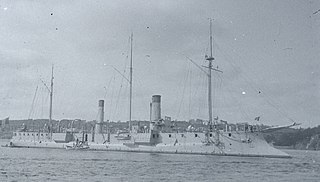
Surcouf was the second Forbin-class protected cruiser built for the French Navy in the late 1880s and early 1890s. The Forbin-class cruisers were built as part of a construction program intended to provide scouts for the main battle fleet. They were based on the earlier unprotected cruiser Milan, with the addition of an armor deck to improve their usefulness in battle. They had a high top speed for the time, at around 20 knots, and they carried a main battery of four 138 mm (5.4 in) guns.
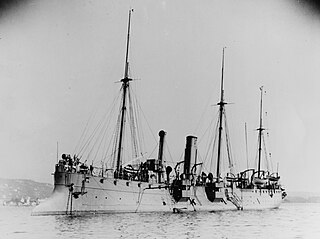
Lalande was a protected cruiser of the Troude class built for the French Navy in the late 1880s and early 1890s. The class was built as part of a construction program intended to provide scouts for the main battle fleet. They were based on the preceding Forbin class, the primary improvement being the addition of armor to the conning tower. Lalande was built in the 1880s and was completed in late 1890. She was armed with a main battery of four 138 mm (5.4 in) guns, protected with an armor deck that was 41 mm (1.6 in) thick, and had a top speed of 20.5 knots.

Linois was the lead ship of her class of protected cruisers built for the French Navy in the 1890s. The class was ordered as part of a construction program directed at strengthening the fleet's cruiser force. At the time, France was concerned with the growing naval threat of the Italian and German fleets, and the new cruisers were intended to serve with the main fleet, and overseas in the French colonial empire. Linois was armed with a main battery of four 138.6 mm (5.5 in) guns, was protected by an armored deck 40 mm (1.6 in) thick, and had a top speed of 20.5 knots.

D'Assas was the lead ship of her class of protected cruisers built for the French Navy in the 1890s. The D'Assas-class cruisers were ordered as part of a construction program directed at strengthening the fleet's cruiser force. At the time, France was concerned with the growing naval threat of the Italian and German fleets, and the new cruisers were intended to serve with the main fleet, and overseas in the French colonial empire. D'Assas was armed with a main battery of six 164 mm (6.5 in) guns, was protected by an armor deck that was 70 to 80 mm thick, and was capable of steaming at a top speed of 20 knots.

Cassard was a D'Assas-class protected cruiser built for the French Navy in the 1890s. The D'Assas-class cruisers were ordered as part of a construction program directed at strengthening the fleet's cruiser force at a time the country was concerned with the growing naval threat of the Italian and German fleets. The new cruisers were intended to serve with the main fleet and overseas in the French colonial empire. Cassard was armed with a main battery of six 164 mm (6.5 in) guns, was protected by an armor deck that was 70 to 80 mm thick, and was capable of steaming at a top speed of 20 knots.

Du Chayla was a protected cruiser built for the French Navy in the 1890s; she was a member of the D'Assas class. The D'Assas-class cruisers were ordered as part of a construction program directed at strengthening the fleet's cruiser force at a time the country was concerned with the growing naval threat of the Italian and German fleets. The new cruisers were intended to serve with the main fleet and overseas in the French colonial empire. Du Chayla was armed with a main battery of six 164 mm (6.5 in) guns, was protected by an armor deck that was 70 to 80 mm thick, and was capable of steaming at a top speed of 20 knots.

Cassini was the second member of the D'Iberville class of torpedo cruisers built for the French Navy in the 1890s. The class is also sometimes classified as torpedo gunboats or torpedo avisos. The D'Iberville-class ships were a development of earlier torpedo cruisers, with the chief improvement being a significantly higher speed. Cassini was armed with three 450 mm (17.7 in) torpedo tubes and a single 100 mm (3.9 in) gun as her primary offensive armament.
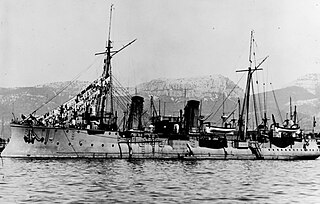
Casabianca was the third and final member of the D'Iberville class of torpedo cruisers built for the French Navy in the 1890s. The class is also sometimes classified as torpedo gunboats or torpedo avisos. The D'Iberville-class ships were a development of earlier torpedo cruisers, with the chief improvement being a significantly higher speed. Casabianca was armed with three 450 mm (17.7 in) torpedo tubes and a single 100 mm (3.9 in) gun as her primary offensive armament.
